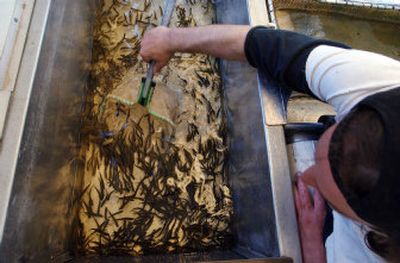Some hatchery fish make leap

GRANTS PASS, Ore. – New research confirms that steelhead raised for generations in hatcheries do poorly when they try to reproduce in the wild, but the first generation of fish raised from wild parents in hatcheries are as successful at reproducing in their native rivers as their wild cousins.
The results of genetically testing some 15,000 steelhead returning to the Hood River in Oregon over the past 15 years offer support for federal policies using hatcheries to bolster threatened and endangered wild runs of salmon and steelhead in the Columbia Basin.
But Oregon State University geneticist Michael Blouin, lead author of the study posted last week in the online version of the journal Conservation Biology, cautioned that relying on hatcheries to sustain salmon runs is likely to fail in the long run without restoring river habitats, because the fish raised from wild eggs hatcheries will soon evolve traits ill-suited to the wild.
In hatchery programs, “we have essentially created a fish version of white lab mice,” Blouin said. “This means they are very well adapted to being born in a little plastic tray and being raised in a concrete pond and fed fish chow. They don’t survive that well in the wild.”
Hatchery fish make up about two-thirds of the salmon and steelhead returning each year to the Columbia Basin, the largest producer of salmon on the West Coast. The returns represent just 5 percent of historical levels before dams, logging, agriculture and urban development destroyed much of their habitat.
Conservation groups, Indian tribes, anglers, state and federal agencies, the timber industry, agricultural groups and property rights groups have been battling for decades over whether to rely on hatcheries.
In 2001, a federal judge ruled that Oregon coastal coho raised in hatcheries must get the same protection under the Endangered Species Act as Oregon coastal coho that spawned in the wild, despite the fact that the hatchery fish were descended from genetic stocks far outside the region.
The federal salmon hatchery policy adopted in 2004 to comply with the ruling was guided by preliminary results of the Hood River study, said Bob Lohn, northwest regional director of the National Oceanographic and Atmospheric Administration Fisheries Service, which is in charge of restoring salmon.
“We don’t expect this to cause us to make major changes,” Lohn said. “But it certainly adds importance to the hatchery reform effort that is now ongoing in the Columbia River system.”
NOAA Fisheries is reviewing 189 different hatchery programs, deciding which will keep producing fish and which should be shut down or forced to adopt modern techniques. It is expected to be completed in about six months, Lohn said.
Bill Bakke of the Native Fish Society said other studies have shown that even hatchery fish bred from wild eggs are inferior to wild fish in behavior, body size and other characteristics that determine their survival.
He said he expected state and federal agencies that operate salmon hatcheries to use the study to justify expanding programs based on wild brood stock, despite the study’s cautionary note that they were likely to fail in the long run.
“This is the end of wild steelhead in the Northwest,” he said.